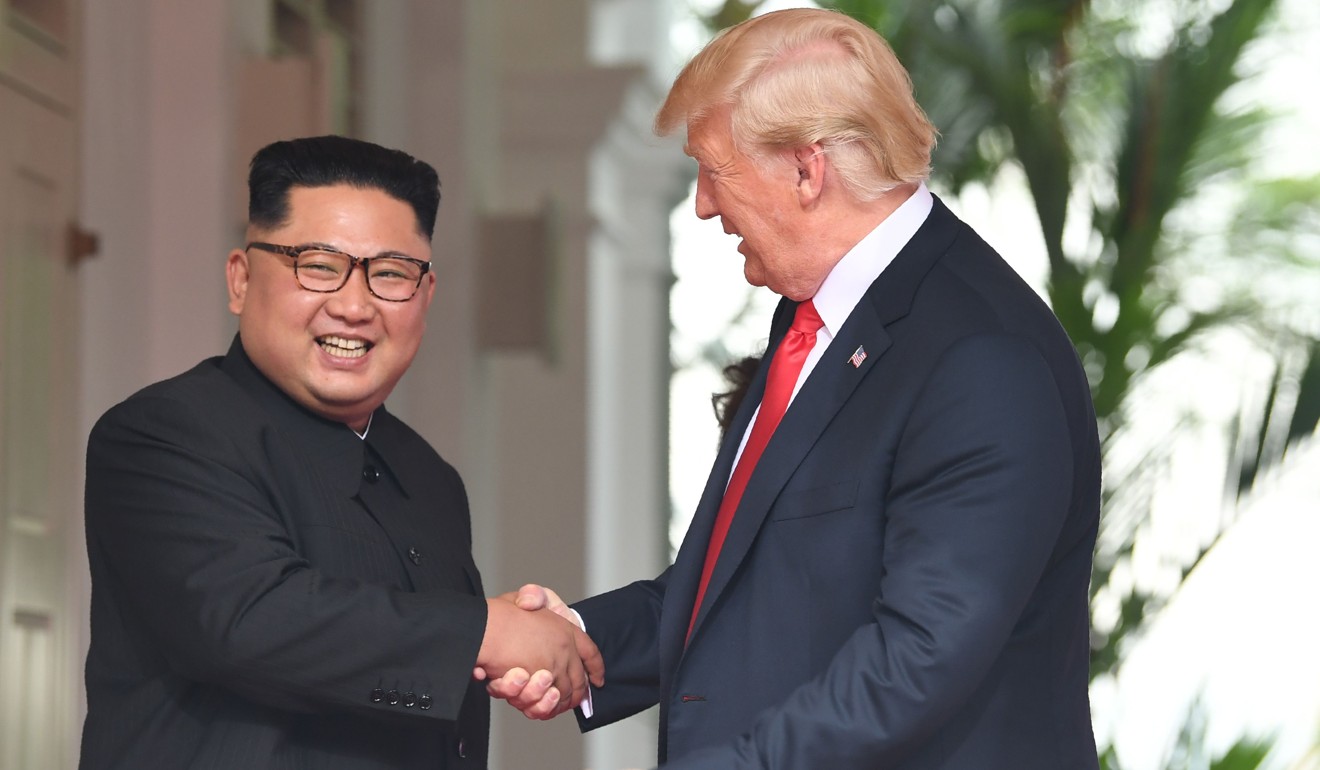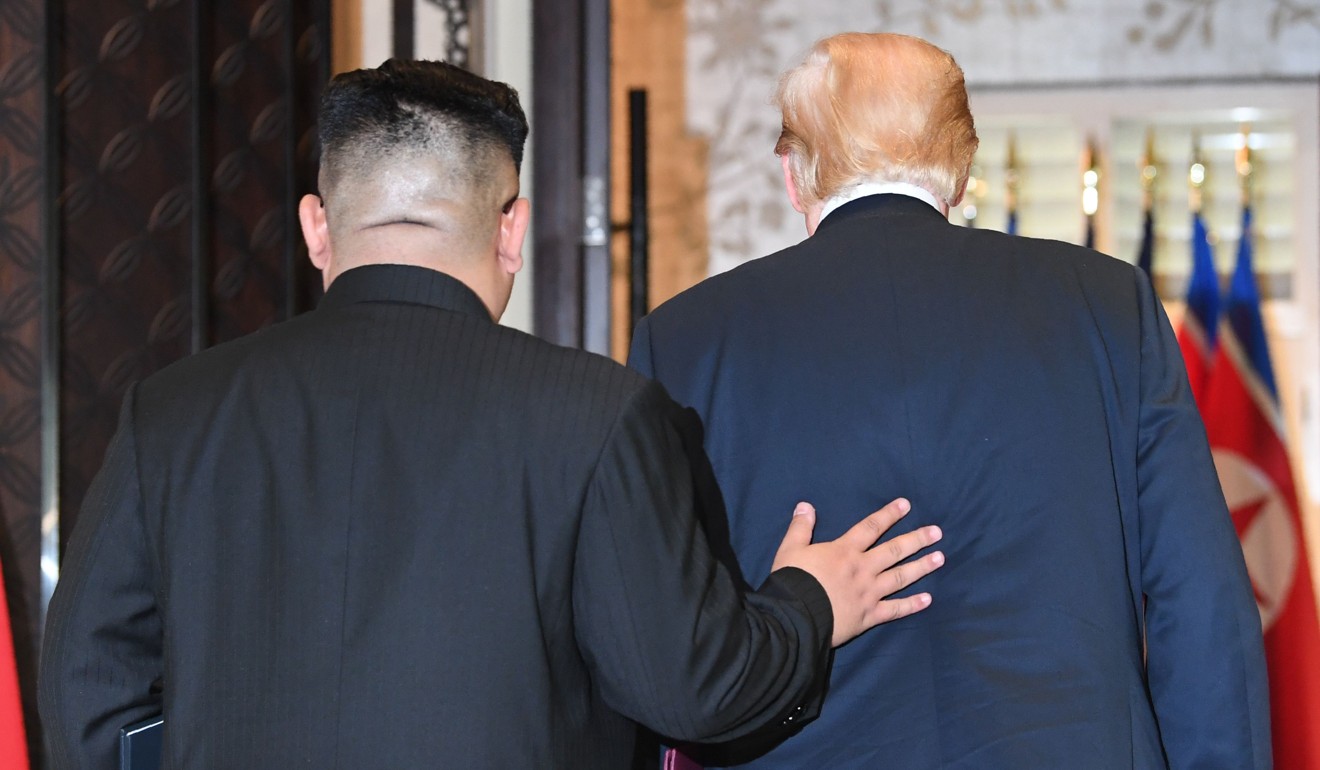
Donald Trump and Kim Jong-un’s body language was a complex display of power, politeness and clash of cultures
Body language experts give their take on the demeanour and actions of both leaders at the historic summit
A power battle played out between Donald Trump and Kim Jong-un at Tuesday morning’s highly anticipated meeting, with both leaders trying to be dominant, according to body language experts.
At times Kim seemed the more neutral, and even uncomfortable, while Trump appeared to be the one more at ease and in control.
But cultural differences could account for Kim’s lack of eye contact and smiles, experts said.
It was the first time leaders of the United States and North Korea had ever met, as two nations are technically still at war and without any diplomatic relations.
The countries were flirting with nuclear war as recently as January, with the leaders sharing a tense relationship, exchanging insults like “little rocket man” and “dotard”.
But at 9am on Tuesday they finally met at the five-star Capella Hotel on the secluded resort island of Sentosa, just off Singapore’s southern coast.
Handshakes and history as Donald Trump and Kim Jong-un sign ‘comprehensive’ agreement
The entrance
Both leaders arrived without a trace of a smile.
Kim, who has ruled North Korea since 2011, pulled up first, a few minutes before 9am, with a stiff look on his face, carrying a notebook, which US body language expert Patti Wood said was more significant than it may have appeared.
“It tells us he is not planning to be off-the-cuff in the meeting,” she said.
“Someone else is not carrying it for him – having other people carry his artifacts is his baseline. It may indicate more concern that he be prepared for the meeting.”
Five minutes later, Trump emerged from his bulletproof car, nicknamed “The Beast”, without a smile and empty-handed.
Wood said a punctual arrival was unusual for the US president, who kept leaders waiting twice at last week’s G7 summit.
“Arriving early typically signifies that the event is important to you,” she said.
The pair walked slowly toward each other for a photo session and a long handshake, which was to last roughly nine seconds, in front of six North Korean and six US flags.
“Both stood erect and walked in medium-length steps, which projects confidence,” said Australian body language expert Allan Pease.
The leaders arrived at the stage at the same time, but Trump offered his hand to shake first.
The handshake
First, a much-awaited moment in itself.
Trump’s signature power-grip handshake is often followed by a wrenching of the arm, as with French President Emmanuel Macron in May 2017 and Japanese Prime Minister Shinzo Abe in April. Although that was not offered to Kim, he did maintain an alpha demeanour.
“Trump gives an upper-outer-arm pat that is called the politician’s handshake, allowing the person using it to show dominance,” Wood said.
He touched Kim several times on the arm, not to indicate warmth but to “signal power and Trump’s desire to look in control of the meeting”.
US diplomats are trained not to do extra power-touches because they are a sign of disrespect, she added, but Trump is known to be a rule-breaker in his non-verbal behaviour.
His talking controlled what they would do next, and he physically led the North Korean leader, to show control, Wood said.
If you didn’t know who they were, argued Pease, “you would conclude Trump was an older, fatherly type, directing a younger, less experienced Kim”.
Kim was trying to keep his distance during such an extended handshake, according to Dr Leow Chee Seng, co-founder of Humanology, a research, consultancy and training organisation specialising in attitude and behaviour, based in Kuala Lumpur.
“He does not want to tolerate Trump and the pressure he feels from his body language,” Leow said. Kim’s retaliatory tap on Trump’s shoulder shows “you need to listen to me”.
Both were avoiding being pulled in or controlled by the other, said Pease.

Behind the smiles
After a photo session and chat on the sidelines, Kim offered his first smile.
In Korean culture, “the smile is more likely to be a mask to cover true emotions and appear neutral and polite” than be a display of happiness, Wood said.
Smiling widely is not always perceived as a positive thing in Korea and in some cases can be viewed as an admission of guilt or foolishness, contrasting with American culture.
Kim’s attitude seemed to differ from that in his meetings with Chinese President Xi Jinping in March, when his note-taking projected a humble image on his first trip overseas as leader, and with South Korean President Moon Jae-in in April, when he seemed relaxed and full of smiles.
Trump seemed more energetic and relaxed, offering “some micro-smiling facial expressions along with his normal baseline squinting”, Wood said.
During their walk to the meeting room, the power play continued.
“Both politicians are trying to be dominant and get power by increasing the surface area when walking,” Leow said.
“They swing hands from left to right to increase the area.”
Trump “pushing” Kim into the room “with energy” again showed he wanted to be in control, he said.
When they sat down to talk, Kim displayed less confidence than Trump.
The US president sat with his hands in a steeple gesture, displaying his trademark confidence, Pease and Leow agreed.
While Kim’s extension of his leg indicated confidence, the North Korean leader’s hand-rubbing and lean to one side showed signs of stress and being uncomfortable, Leow said, while his grip on his chair also indicated tension, Pease said.
Eye to eye
During the handshake and when seated next to each other, Trump appeared to be staring Kim down as the North Korean leader looked away then back at the president haltingly.
While some viewers used Twitter to talk about awkward eye contact, Pease explained that it was a cultural difference rather than a sign of submission. Differing perspectives spoke volumes of the immense culture gap and differences at play between the nations.
In the West, it is disingenuous not to look someone in the eye, whereas in Korean culture it is polite not to make full eye contact with someone who is elder or superior. Kim displayed the same courtesy to South Korea’s Moon in April.

Such cultural differences could make room for misunderstanding between the leaders, given Trump’s record, demonstrated during his infamous 19-second handshake with Abe earlier this year.
The US president could make his own interpretation of Kim’s seemingly deferential behaviour and get a confidence boost, said Jenna Gibson, director of communications at the Korea Economic Institute in Washington.
“He might think, ‘This guy who is supposedly so scary in North Korea isn’t able to look me in the eye,’” said Gibson.
But, she said, Kim can show some flexibility.
“Kim knows Trump doesn’t know anything about Korean culture, and also knows Trump is particularly informal, even compared with other American presidents,” Gibson said.
“I think Kim will give Trump a bit of leeway on any possible cultural misunderstandings.”
Meeting expectations?
Tuesday’s meeting had at one point been heralded as a significant step in a deal to denuclearise the Korean peninsula, but the US had recently played down its importance, increasingly projecting it as a way to establish further negotiations.
Yet stakes remained high, with the result set to have an impact on global peace and the issue of nuclear weapons.
On Saturday, before leaving the G7 meeting in Canada to travel to Singapore, Trump had said he would sense “within the first minute” of meeting Kim whether he was serious in his intentions, and would know from “my touch, my feel”.
Additional reporting from Marie Lee


